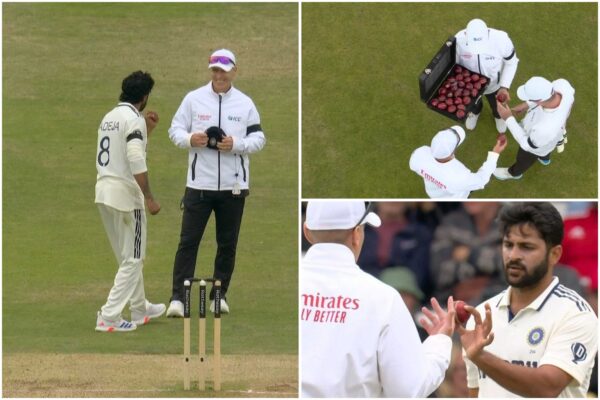
Indian players including skipper Shubman Gill, Rishabh Pant, Shardul Thakur and Jasprit Bumrah requested for a ball change on four occasions within 27 years on last day.

It’s been a difficult Day 5 for the Indian cricket team so far in the ENG vs IND 1st Test. Defending 350 runs on the final day of the Headingley Test, India haven’t tasted success yet as the hosts, England, are cruising towards the target. India skipper Shubman Gill, vice-captain Rishabh Pant, Shardul Thakur and pace spearhead Jasprit Bumrah had chats with on-field umpires requesting the ball change on multiple occasions.
The first appeal from Men in Blue came midway through the 14th over of the day. Chris Gaffaney pulled out the measurement instrument and verified that the ball had not lost its shape. There were more requests throughout the morning, before the umpires accepted the ball change after the 27th over. There was a similar passage in the first innings. Pant displayed dissent on one such request and threw the ball on the ground. A day later, the ICC sanctioned him for his act. This brings focus on the ball change-related rules in Test cricket that could have a huge impact on the dynamics of the game.
The bowling team is permitted to opt for a second new ball after every 80 overs in an innings. They can continue with the old ball as long as they want. But there is also a provision that allows the bowling team to request a ball change when the ball loses its shape. There is no limitation on the requests to be made.
Clause 4.2.4 says: “During play, umpires shall periodically and irregularly inspect the condition of the ball and shall retain possession of it at the fall of a wicket, a drinks interval, or any other disruption in play.”
Clause 4.5 then adds: “If, during play, the ball cannot be found or recovered or the umpires agree that it has become unfit for play through normal use, the umpires shall replace it with a ball which has had wear comparable with that which the previous ball had received before the need for its replacement. When the ball is replaced, the umpires shall inform the batters and the fielding captain.”
The ball passed through the gauge successfully in all those instances when the ball was not changed. Hence, the umpires denied the India’s requests for a ball change.
ALSO READ:
The condition of the ball is crucial. The new ball has more lacquer and is hard, which results in the bowler getting more bounce, swing and pace. However, as the game progresses, the ball wears out, loses its shine and soft. It becomes less effective, but if maintained well and it potentially offers reverse swing. or spin. Hence, the team aims to maintain the ball closely to get some help from it as it gets older.
However, it also has another side. The new ball tends to come nicely on the bat and make the stroke a little bit easier, which could lead to an increase in the flow of runs.
For more updates, follow CricXtasy on Facebook, Instagram, Twitter, Telegram, and YouTube.